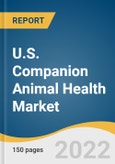The U.S. companion animal health market size is expected to reach USD 11.39 billion by 2030. It is expected to expand at a CAGR of 10.2% from 2022 to 2030. The rising number of pet owners seeking better healthcare services, healthier quality foods, and high-end grooming and training services for their companion animals is a major driver for this market. According to the American Pet Products Association (National Pet Owners Survey), 85 million households in the U.S. own a pet, especially dogs, out of which 60.2 million own multiple pets. Moreover, high-income families amounted to approximately 60% of the total spending. In recent years, pet adoption has shown immense growth. This is primarily attributed to the fact that people are healthier and happier in the presence of pets, as found by the Human-Animal Bond Research Initiative Foundation (HABRI).
With the rising adoption of companion animals and growing concerns over their health, there comes a direct association with pet insurance. Presently, pet insurance accounts for a small segment of the insurance industry. The Covid-19 pandemic positively impacted the market growth in the U.S. Key players such as Boehringer Ingelheim Animal Health, Chewy, Elanco, MWI Animal Health, Covetrus, and PetIQ focused on expanding their telemedicine solutions into the market as governments relaxed governance to enable more flexible veterinary examinations during the coronavirus pandemic.
Approval of novel therapeutics and companion animal vaccines continues to present this market with lucrative growth opportunities. Ongoing trends for the adoption of e-commerce, pet insurance, veterinary telemedicine, point of care diagnostic testing, and digitalization of veterinary practices are further accelerated by the crisis of COVID-19.
Groundbreaking technological advances are rapidly transforming the pet health industry. These expansions are maximizing the potential for growth. Companies are taking strategic initiatives in pet health, such as the adoption of big data, wearable technologies to monitor pet health, and the inclusion of stem cell therapy. Moreover, established players are focusing on expanding their portfolios. For instance, Elanco acquired Bayer AG’s animal health business unit in August 2019.
The U.S. captured a substantial share of the market. The share attained by this country is primarily a consequence of the presence of prominent market players undertaking extensive expansion strategies. Moreover, the increasing number of R&D investments initiated by the companies is one of the key potential growth factors presumed to be responsible for the sizeable share garnered by the U.S.
U.S. Companion Animal Health Market Report Highlights
- Based on animal type, the dog segment held the dominant share in 2021 due to the increasing spending on pet care, specifically in developed regions
- By product, the pharmaceuticals segment is expected to gain popularity in the coming years owing to the growing demand to increase pet longevity and rising R&D activities
- On the basis of distribution channel, the e-commerce segment is anticipated to witness rapid growth over the forecast period due to the increased convenience offered to pet owners
- The veterinary hospitals and clinics end-use segment held the largest revenue share of over 80.0% in 2021 due to the growing demand for services such as clinical pathology, toxicology tests, and therapy
- Vetiquinol S.A., Zoetis, Merck, Ceva Santé Animale, Boehringer Ingelheim GmbH, and Elanco are some of the major market participants due to their product offerings and strong regional presence
- Companies are adopting various strategies to gain competitive advantages, such as new product development, partnerships, mergers and acquisitions, collaborations, and regional expansion
This product will be delivered within 1-3 business days.
Table of Contents
Companies Mentioned
- Merck Animal Health
- Ceva Santé Animale
- Vetiquinol S.A.
- Zoetis
- Boehringer Ingelheim GmbH
- Bayer AG
- Elanco
- Virbac, Inc.
- Norbrook Inc.
- Dechra Pharmaceuticals
- Patterson Companies, Inc.
- Vedco Inc.
- Mwi Animal Health
- Covetrus
- Ellevet Sciences
Methodology

LOADING...
Table Information
| Report Attribute | Details |
|---|---|
| No. of Pages | 150 |
| Published | April 2022 |
| Forecast Period | 2022 - 2030 |
| Estimated Market Value ( USD | $ 5.26 Billion |
| Forecasted Market Value ( USD | $ 11.39 Billion |
| Compound Annual Growth Rate | 10.2% |
| Regions Covered | United States |
| No. of Companies Mentioned | 15 |









